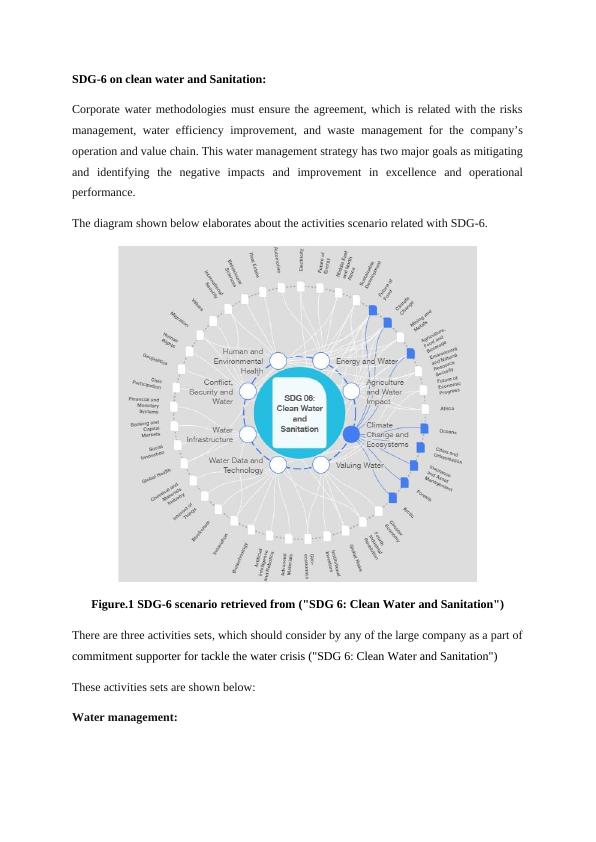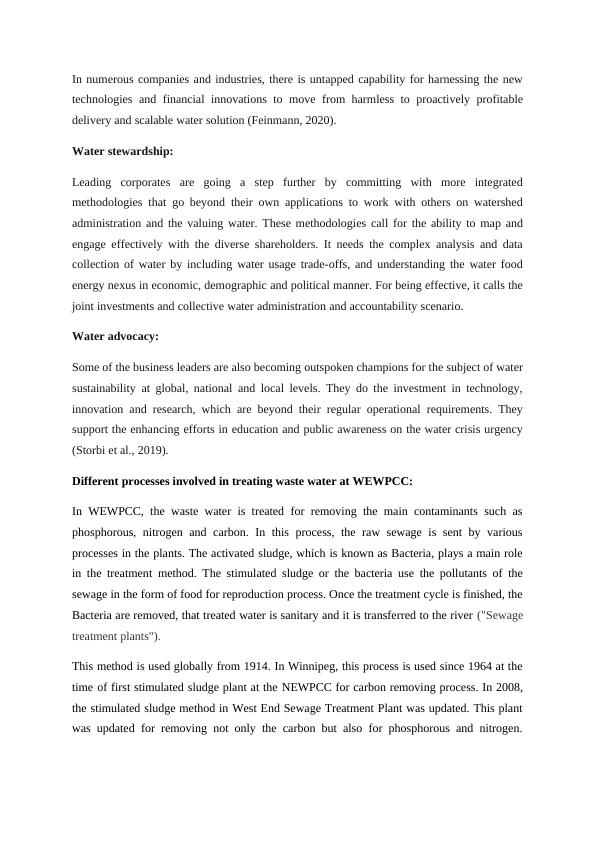Assignment based on the field trip to West End Water Pollution
Added on 2022-09-13
8 Pages1981 Words10 Views
Assignment based on the field trip to West End Water Pollution Control
Center ( WEWPCC) , Winnipeg .
Center ( WEWPCC) , Winnipeg .

SDG-6 on clean water and Sanitation:
Corporate water methodologies must ensure the agreement, which is related with the risks
management, water efficiency improvement, and waste management for the company’s
operation and value chain. This water management strategy has two major goals as mitigating
and identifying the negative impacts and improvement in excellence and operational
performance.
The diagram shown below elaborates about the activities scenario related with SDG-6.
Figure.1 SDG-6 scenario retrieved from ("SDG 6: Clean Water and Sanitation")
There are three activities sets, which should consider by any of the large company as a part of
commitment supporter for tackle the water crisis ("SDG 6: Clean Water and Sanitation")
These activities sets are shown below:
Water management:
Corporate water methodologies must ensure the agreement, which is related with the risks
management, water efficiency improvement, and waste management for the company’s
operation and value chain. This water management strategy has two major goals as mitigating
and identifying the negative impacts and improvement in excellence and operational
performance.
The diagram shown below elaborates about the activities scenario related with SDG-6.
Figure.1 SDG-6 scenario retrieved from ("SDG 6: Clean Water and Sanitation")
There are three activities sets, which should consider by any of the large company as a part of
commitment supporter for tackle the water crisis ("SDG 6: Clean Water and Sanitation")
These activities sets are shown below:
Water management:

In numerous companies and industries, there is untapped capability for harnessing the new
technologies and financial innovations to move from harmless to proactively profitable
delivery and scalable water solution (Feinmann, 2020).
Water stewardship:
Leading corporates are going a step further by committing with more integrated
methodologies that go beyond their own applications to work with others on watershed
administration and the valuing water. These methodologies call for the ability to map and
engage effectively with the diverse shareholders. It needs the complex analysis and data
collection of water by including water usage trade-offs, and understanding the water food
energy nexus in economic, demographic and political manner. For being effective, it calls the
joint investments and collective water administration and accountability scenario.
Water advocacy:
Some of the business leaders are also becoming outspoken champions for the subject of water
sustainability at global, national and local levels. They do the investment in technology,
innovation and research, which are beyond their regular operational requirements. They
support the enhancing efforts in education and public awareness on the water crisis urgency
(Storbi et al., 2019).
Different processes involved in treating waste water at WEWPCC:
In WEWPCC, the waste water is treated for removing the main contaminants such as
phosphorous, nitrogen and carbon. In this process, the raw sewage is sent by various
processes in the plants. The activated sludge, which is known as Bacteria, plays a main role
in the treatment method. The stimulated sludge or the bacteria use the pollutants of the
sewage in the form of food for reproduction process. Once the treatment cycle is finished, the
Bacteria are removed, that treated water is sanitary and it is transferred to the river ("Sewage
treatment plants").
This method is used globally from 1914. In Winnipeg, this process is used since 1964 at the
time of first stimulated sludge plant at the NEWPCC for carbon removing process. In 2008,
the stimulated sludge method in West End Sewage Treatment Plant was updated. This plant
was updated for removing not only the carbon but also for phosphorous and nitrogen.
technologies and financial innovations to move from harmless to proactively profitable
delivery and scalable water solution (Feinmann, 2020).
Water stewardship:
Leading corporates are going a step further by committing with more integrated
methodologies that go beyond their own applications to work with others on watershed
administration and the valuing water. These methodologies call for the ability to map and
engage effectively with the diverse shareholders. It needs the complex analysis and data
collection of water by including water usage trade-offs, and understanding the water food
energy nexus in economic, demographic and political manner. For being effective, it calls the
joint investments and collective water administration and accountability scenario.
Water advocacy:
Some of the business leaders are also becoming outspoken champions for the subject of water
sustainability at global, national and local levels. They do the investment in technology,
innovation and research, which are beyond their regular operational requirements. They
support the enhancing efforts in education and public awareness on the water crisis urgency
(Storbi et al., 2019).
Different processes involved in treating waste water at WEWPCC:
In WEWPCC, the waste water is treated for removing the main contaminants such as
phosphorous, nitrogen and carbon. In this process, the raw sewage is sent by various
processes in the plants. The activated sludge, which is known as Bacteria, plays a main role
in the treatment method. The stimulated sludge or the bacteria use the pollutants of the
sewage in the form of food for reproduction process. Once the treatment cycle is finished, the
Bacteria are removed, that treated water is sanitary and it is transferred to the river ("Sewage
treatment plants").
This method is used globally from 1914. In Winnipeg, this process is used since 1964 at the
time of first stimulated sludge plant at the NEWPCC for carbon removing process. In 2008,
the stimulated sludge method in West End Sewage Treatment Plant was updated. This plant
was updated for removing not only the carbon but also for phosphorous and nitrogen.

End of preview
Want to access all the pages? Upload your documents or become a member.
Related Documents
Advanced Water & Wastewater Engineering Case Study 2022lg...
|13
|4556
|28
Waste and Waste Water Treatment PDFlg...
|13
|2971
|55
Bioremediation of Waste Water Treatmentlg...
|9
|2209
|115
Recovery of Nutrient and Stabilisation Techniques in Source Separated Urinelg...
|9
|2833
|354
